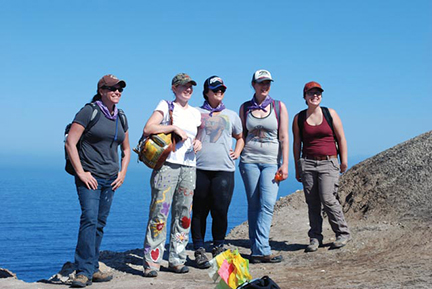Unearthing the Human Story of California’s Channel Islands
By Jennifer E. Perry, Assistant Professor of Anthropology
California’s Channel Islands are commonly referred to as the “Galapagos Islands” of the northern hemisphere because they are home to many unique plant and animal species. Birders flock to the islands to catch glimpses of the island scrub jay; hikers and campers delight in the island fox; and, snorkelers and scuba divers swim alongside fish, sea lions, and dolphins.
Despite this rich biodiversity, however, many are surprised to learn that the human story of the Channel Islands is equally as diverse and fascinating. Since only one of the islands, Catalina, is home to permanent residents today, few tourists realize that Chumash and Tongva communities dotted the islands just 200 years ago and that they were connected through marriage, religion, and trade. Furthermore, we know from decades of archaeological research that Native Americans have lived on all eight of the islands for more than 13,000 years. In fact, growing evidence suggests that the islands were one of the earliest places to be colonized in North America!
Archaeologists such as myself have been dedicated to understanding and sharing this amazing human story. I first fell in love with the islands when I enrolled in an undergraduate field methods class that took place on San Clemente Island. In the 20 years since then, I have conducted research on human-environment interactions on seven out of the eight islands, being interested in how past peoples capitalized on the unique resources available to them and how their decisions influenced the character of the islands today. As one example, Santa Cruz Island is a major source of a rock known as chert, which islanders used to manufacture stone tools including spears, knives, and drills. They used the drills to make their canoe planks and shell bead money, both of which were vital to their economy and to the extensive trade systems of southern California.
As another example, during excavations I unearthed evidence of a feast that took place about 200 years ago in the central valley of Santa Cruz Island. High-status items, such as shell bead money and the bones of dolphins and swordfish, tell me that important people were assembled here from different villages. As I analyze these artifacts and food remains, I continue to marvel at the sophisticated ways of the people who have come before me, and I feel connected to the communities of people attracted to the Channel Islands, past, present, and future.
Perry is the co-editor and a co-author of a forthcoming book on “California’s Channel Islands: The Archaeology of Human-Environment Interactions” (University of Utah Press, scheduled to be published in October 2013).
